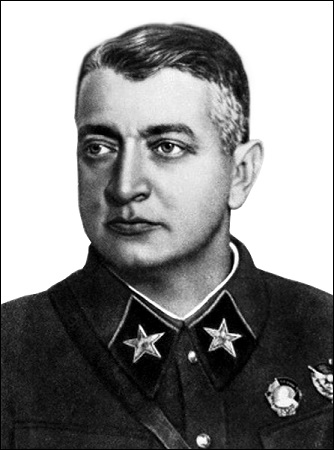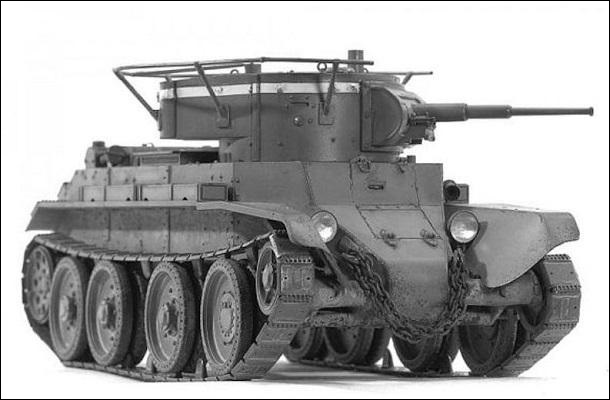● ● ●
The story of the Red Army in World
War II is largely the account of its prewar development of
the deep battle concept, and the wartime reforms,
carried out under the spur of grim necessity, that aligned
its actual capabilities with the tactical and operational
doctrines that stemmed from the basic concept. Four battles—each really
constituting a series of battles—illustrate this process: the
1941-42 Moscow counteroffensive, the 1943-43 Stalingrad
offensive, the 1943 Battle of Kursk, and the 1944
Belorussian offensive. Each will be described and analyzed
in this series of articles.
TERMS DEFINED
Tactical doctrine
encompasses the battlefield employment of military forces:
how the various arms—infantry, artillery, armor, etc.—are
combined and how they fight. Broadly speaking, tactical
doctrine governs the activities of units from the level of
the rifle squad to that of the division. For example, the
manner in which a rifle battalion employs the assets at its
disposal is a matter of tactics: how its heavy machine,
mortars, antitank weapons, etc. should be employed to
support its rifle when defending or on the attack. For the
commander of a regiment, brigade or division tactical
decision-making involves the coordination of various
sub-units of the formation and the distribution of support:
artillery, armor, engineers, etc.
Operational doctrine is mainly the
concern of the higher echelons of command: for the Red Army,
these were the field armies and the fronts (army groups). A
major military operation has an objective, be it
geographical or conceptual, and usually the two interact. For
example, the geographical objective of an offensive might be
a rail junction, with the conceptual objective of disrupting
or severing the enemy’s rear communications. If successful, such
an offensive might compel the enemy to carry out a
large-scale withdrawal, or it might lead to the encirclement
and destruction of a portion of his forces. Operational
doctrine describes how the actions of large units are
combined and sequenced to secure the overall objective.
THE DEEP BATTLE
The Red Army’s 1941-45 tactical and
operational doctrines were based on the concept of the deep
battle, which was developed in the late 1920s and early
1930s under the leadership of Marshal
Mikhail Tukhachevsky. Simply put, deep battle doctrine
envisioned an operational deployment in depth.
The deep battle
was to be fought by a three-echelon deployment of forces
under command of a front (army group). The first echelon,
strong in infantry and artillery, would make the initial
breakthrough or, if standing on the defensive, would parry
enemy’s initial blow. The second echelon, consisting of
mobile forces, would then go
over to the attack (or counterattack), driving toward the
designated operational objectives, far in the enemy’s rear
area. The third echelon was the reserve, to be committed as
the development of the battle required.

Mikhail Nikolayevich
Tukhachevsky (Wikimedia
Commons)
On the attack,
this three-echelon deployment would facilitate a strike deep
into the enemy’s rear area after the initial breakthrough.
On defense it would function as a shock absorber, slowing or
stopping the enemy’s attack and creating favorable
conditions for counterattacks and, possibly, a transition to
a full counteroffensive. Either way the deep battle required
large mobile units, and this led to the formation of the Red
Army’s first
tank corps
in the early 1930s. These joined
the existing cavalry corps, constituting the mobile
exploitation force required to fight the deep battle.
In a sense deep battle doctrine was
a refinement by mechanization of the Russian Army's
traditional steamroller tactics. It relied on mass more than
finesse: blowing a hole in the enemy's line, then racing to
seize key objectives in the rear. The tactical flexibility
that the German panzers would later display on the
battlefield was not developed by the Red Army, and was
probably beyond its abilities. But a blunt instrument can be
just as deadly as a rapier if properly handled, especially
in combination with the numerical superiority on which the
Red Army could count.
But there were dissenters who
thought that attrition, not the deep battle, was the proper
operational doctrine for the Red Army. Reliance, they
argued, should be placed on the firepower of massed
artillery and infantry, both of which the USSR could provide
in plenty, to wear down the enemy, ultimately breaking his
resistance. Tanks
should
therefore be distributed among the rifle
corps to provide the infantry with close support. As things
turned out the rival concepts were to some extent blended,
it being recognized that firepower and numerical superiority
at the point of attack would facilitate the breakthrough necessary to set
the stage for a deep operational penetration.

The BT-7 entered service
in 1935 and was the Red Army's principal light tank at the
beginning of the war (Tank Encyclopedia)
Unfortunately for the USSR the
military purge of 1937-38 eliminated Tukhachevsky and the
officers associated with his ideas, which therefore fell
into disrepute. The tank corps were disbanded with the
intention of distributing their brigades among the infantry
corps. But the rising threat of Nazi Germany inspired second
thoughts that were confirmed by the 1939-40 Winter War with
Finland. Though sheer weight of numbers eventually compelled
the Finns to sue for peace, the Red Army’s dismal
performance in the initial stage of the conflict both angered
and alarmed Stalin. Reforms were immediately introduced,
including the reinstatement of large mechanized units in the
Red Army’s order of battle.
By the time of the German invasion
(22 June 1941) some thirty mechanized corps existed, each with two
tank divisions and one mechanized infantry division. On
paper, this was a formidable array. But many of the
available tanks were obsolete and thanks to a
shortage of motor vehicles, many of the mechanized corps’
infantry and artillery units still had to rely on horses.
More serious still was the shortage of trained artillery,
engineer, signal and other technical troops. Thanks to these
deficiencies the mechanized corps proved ineffective, and
they were largely destroyed in the opening battles.
Subsequently the
Red Army raised new mobile formations—a new type of tank
corps
and the
mechanized
corps—with
a simplified organization suited to its capabilities. They
were the basic units of the
tank army
and the shock army,
which together with other developments such as a
reorganization of the
artillery
permitted a return to Tukhachevsky’s concept of the deep
battle. Up to 1943, however, the Army’s mobile forces were
insufficient in numbers, striking power and experience to
convert a successful breakthrough into a decisive
operational penetration. The primary problem was a lack of
effective leadership at the tactical level. Only the passage
of time could correct this problem and during the bitter
battles of 1941-42 there gradually emerged cadres of
combat-experienced leaders capable of exploiting the
capabilities of the units they commanded.
The Moscow Counteroffensive & the
General Offensive 1941-42
• The Stalingrad Campaign 1942-43
The Battle of Krusk 1943
• The Belorussian Offensive 1944
● ● ●